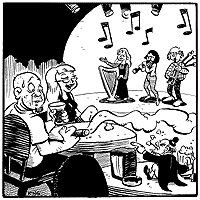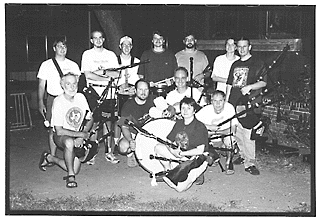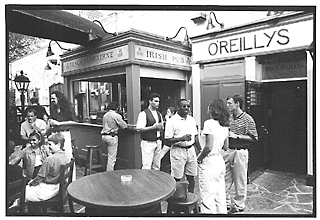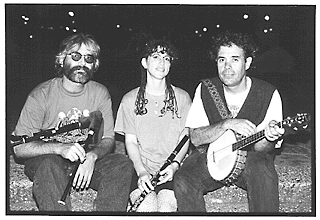Faerie Tales
Another Scene? The Original Scene
By Christopher Gray, Fri., Aug. 15, 1997
|
|
So, what to do with a "scene" that's been around virtually since time began?
The first thing to do is stop using that damn word. This isn't something taking up space between Tommy Hilfiger, Mountain Dew, and Discover Card ads. This is music so vital to the culture it describes that one wouldn't exist without the other. Music so spiritual that even those who play it have trouble describing it -- and so evocative that people who've never heard it choke up within seconds. Music so lasting that after thousands of years, it still revolves around a small core of instruments, sounds, and stories, yet so mysterious most people are unaware it even exists.
Ever since they came to the British Isles, long before Christ was even a prophecy, the rugged inhabitants of Ireland, Scotland, Wales, Cornwall, and the Isle of Man, plus nearby Brittany (France) and Galicia (Spain), have had their music. And, as their countless legions of descendents spread to all corners of the globe -- a whole bunch to the United States, and a good-sized lump of that to Texas -- they brought it with them. Most of the time, music was all they had.
"I don't know that I can put words on that feeling," says Marie Van Wart, former president of the Austin chapter of the Gaelic League, and current president of the Austin Celtic Association (ACA). "You hear a lively jig, and you want to dance. You hear a really sad ballad, and it makes you want to cry. It stirs something in people that taps into a really deep, shared level of emotion. If you go listen to Irish music almost anywhere, the whole audience will just be captivated and not talking and visiting like you would find in another club setting. They seem rapt."
Formed in March as a reaction to the growing local interest in Celtic Music, the ACA seeks to unite Austin's many Celtic-themed organizations, including Irish step-dancing groups, Scottish pipe & drum bands, and the Austin Friends of Traditional Music. Beyond that, the ACA's main purpose is to promote and prepare for their upcoming festival, a two-day event scheduled for October 11 and 12 on a large expanse of farmland outside Round Rock.
The festival, modeled on a traditional ceilidh (social gathering), will feature Irish and Scottish dance, storytelling, and craft demonstrations, children's activities, Celtic information booths from all over Texas, and several hours' worth of music. Though groups from as far away as Tucson (the Mollys) and Australia (Kelly's Revenge) are scheduled to appear, the bulk of the lineup comes from Texas. Dallas (the Killdares), San Antonio (Claymhor, St. James' Gate), and Houston (Ceili's Muse, Gordian Knot, Nobody's Reel) are all represented, but almost half of the festival's scheduled 20 acts call Central Texas home.
Not that this is anything new. In Celtic circles, Scottish music usually plays sidekick to its Irish cousin, but both Ed Miller, whose folk songs bridge Robert Burns and David Byrne, and the Silver Thistle Pipe & Drum Band, whose rehearsals Friday evenings in front of the Dog & Duck are a happy accident for many a downtown passerby, are booked to play the festival, both doing what they've been doing locally for years. What is new -- or new again -- is the amount of attention they and this ancient form of music is suddenly attracting.
"One has to wonder, really, if this type of music doesn't express some form of collective consciousness that we're barely cognizant of, but still brings us all together," says Van Wart. "I don't know to what, but it does seem to. It doesn't ever seem to die out."
|
|
Fadó also just adopted the peripatetic Saturday evening sessions, which had been without a home ever since Señor O'Brien's closed, and moved them to Sunday evenings starting this month. Waterloo Ice House at Sixth & Lamar, meanwhile, has hosted a number of standing-room-only ACA fundraisers since the organization's inception. The Cactus Cafe, in addition to attracting touring talent like Steeleye Span, the Battlefield Band, and Katell Keineg, regularly features locals Miller, Ptarmigan, and Hair of the Dog, regional talent like Ceili's Muse, St. James Gate, and Nobody's Reel, and recently had a Friday night "Cactus Celtic Blowout" with the familiar Two O'Clock Courage/Crazy Jane twosome.
Even the Hole in the Wall has gotten into the act of late, hosting a show by Houston's Clandestine (currently off competing for Best New Band at the premier Celtic gathering in the en-tar world, Brittany's Festival Interceltique) and Crazy Jane, which packed the club to the gills on a night easily as boisterous and harum-scarum as any Prima Donnas, Adults, or Gourds Saturnalia.
Crazy Jane & the Bishop fiddle/mandolin player Spot says the most important thing about that night was "that it wasn't a fundraiser." It was just another night at a crowded bar, albeit one that showed how broad and mystical the appeal of Celtic music can be. Spot says he first realized he could play Celtic tunes at the 1990 North Texas Irish Music Festival during a hotel tune session featuring Miller, guitarist Rich Brotherton, and members of Altan, the Celtic supergroup who sold out the Paramount last fall. The idea to bring it to Hole in the Wall came when Crazy Jane opened for the Damnations there in February. "Some of the melodies are just timeless," he says. "They're just so durable. Those melodies are going to outlast us all. Maybe the only reason we're here is just to keep the melodies going."
Though these melodies have been in North America for centuries -- since the first boatful of Irishmen docked at Ellis Island or Boston Harbor -- musicians such as those at the Hole in the Wall that night are much more likely to have A Hard Day's Night in their youthful collections than the first Chieftains album.
Spot, for instance, moved to Austin from Los Angeles, where he was a top-shelf punk rock producer (Hüsker Dü, Minutemen, Descendents), because he was "sick of all the punk rock bullshit." Two O'Clock Courage piper/guitarist Steve Rees played Black Sabbath growing up. Spot, Van Wart, and Two O'Clock Courage flautist/singer Jyl Hershman all admit being enthralled by heavy metal pied piper Ian Anderson and Jethro Tull. They remember when the Sixties folk revival brought about bands like Pentangle, Planxty, the Incredible String Band, and Fairport Convention, who spliced traditional melodies and insouciant rock energy together.
Spot says one of this music's selling points is subject matter that would do Nick Cave proud. "I think I've always liked some of the really dark old songs about people living in utter despair, where one person kills another and the baby that's born comes back and says, `Mother, you killed me when I was born' and they go to hell," he says, describing more a prominent theme than a specific song.
His bandmate Larry Rone concurs. "I think there's a pathos to every Irish tune," says Rone, who co-founded the North Texas Irish Music Festival in Dallas and was its entertainment director until he left for graduate school in 1989. "No matter how happy an Irish tune is, there's always an underlying sort of sadness, probably because there's been so much sadness in Ireland. This is why I like it better than anything else. It's so creative, it's from so deep in the soul, because it's from people who are really hurting. The sadness comes out."
One of the first things the Celts learned all those centuries ago was that the best weapons against tragedy and despair are wit, rebelliousness, and faith. Take our sons, our land, even our freedom, but you can't take our souls -- not without one hell of a fight. Song after song details how these passionate people withstood conscription, repression, and near-extermination with little more than their instruments and their kinsmen. It's music that's infinitely more anti-establishment than the most inflammatory punk or hip-hop.
"There's a lot of [songs] that are very topical, even if they're 50, 80, or 100 years old," says Two O'Clock Courage's Hershman. "Ireland and Scotland, too, to a certain extent, are still countries that are repressed by a culture that's not their own."
"The main thing I like about Celtic music is it's gotten me back in touch with a certain energy and spirit in music that I wasn't really finding in a lot of other places," says Spot. "Most rock & roll these days has gotten very corporate. It's just not as vital and gutbucket and basic as it was. Most country music has done the same, and most jazz music has gone the same route. I've heard so much bluegrass, these days I can tell the difference between good bluegrass and bad bluegrass real quick. I don't have a lot of patience for mediocre stuff anymore. Musically, there's just a certain kind of energy that I just don't find anywhere else."
"I live outside of Round Rock," says Rees. "I'd go off and play where I thought I was all alone for a million miles, and I'd have people walking out of the woods going, `I heard you. I live half a mile down the way and I just had to find out about this.' It's almost like a magnet. I'm assuming everybody -- white, black, or oriental -- has some Irish or Scottish blood in them. Somewhere, there's some in there."
|
|
"The spirit world is there," Van Wart says. "It doesn't not exist. It's not up in heaven, it's not in hell, it's there, all around you all the time. We think, `Fairies, yeah, right,' a Walt Disney kind of thing, but I know several Irish people who have seen them. These aren't myths to these people, it's reality. They believe in it. It's very much a part of their lives and their psyche."
"Serge [Laine] in our band uses the word `atavistic,'" says Rone. "I love that word. It's something deep in your genes, something that was there always and once you heard it, you remember it."
And it goes a little deeper still.
"I think it's beyond any kind of genetic race memory," he says. "I lived in Japan for three years and met a number of Japanese people who were obsessed with Irish music. This one guy is as good an Irish guitarist as I've heard outside of Rich Brotherton. He can't speak a word of English, but he's just so into the music it's got to be beyond any kind of racial thing.
"In Japan, I played with this girl, who I turned on to Irish music. Her name's Liza Woo; she's Chinese-American. I met this other guy who's a fiddle player, I can't remember his name, but he plays with a group out of Washington D.C. called Celtic Thunder, and he's Japanese-American. One of the best Irish fiddle players in America is a guy named Tony DeMarco, an Italian-American. And there's a guy named Johnny Harley in Chicago who's black and plays Irish music."
Race memory, collective unconscious, the fairy world, whatever drives this music onward is obviously something mere mortals are still having a hard time comprehending. Or maybe not. Maybe it's just that something so simple seems to take on unearthly qualities in such a complicated age. "Most of the songs are about very simple things," Rees says. "That in and of itself is so foreign to people it's almost mythological."
"I don't think it matters how you grew up, everybody knows fairy tales," Hershman says. "Even if you're totally unfamiliar with the history and background of the Celtic isles, there's something in these songs that just brings you back to when you were a little kid and were told fairy tales."
Perhaps the best explanation of Celtic music's power -- certainly the wordiest -- comes from one of the most unlikeliest places of all: the Internet. Rone maintains the ACA's web page (it gets between 30 and 50 hits a day), and could probably verify that the proliferation of Celtic-themed sites across the World Wide Web might be termed the work of cyberfairies. The Dalraida Celtic Heritage Trust's online compendium of Celtic folklore and mythology (http://www.electricscotland.com/dalraida) says of the nebulous Otherworld: "These lands are the home of our emotive primordial links with our origins, the home of the unknown or the unanswered. Human nature has, from the dawn of self-awareness, always sought to explain the mysteries of life, death, and their surroundings just as we still do. Also like us, that which could not be explained by conscious logic could be accounted for in the ever-present unseen Spirit realms."
The same site's entry for the Clarsach (Celtic harp) lays bare music's essential connection to this mystical place: "The Clarsach was seen by many as a gift from the Gods, giving it an inseparable link with the Otherworld. This was strengthened by the bards themselves, who, through their legends, could carry people on fantastic Otherworld journeys to the lands of Promise. No one can deny the effect the Clarsach has on our emotions, there is no instrument that can compare in sound to its melodious song that can lift and carry us to lands of beauty, sadness, and sorrow like a bird hopping from branch to branch."
Back down here on Earth, not everyone is even aware music so pure and fantastic exists, let alone that one of their neighbors or co-workers could be one of those bards mythology refers to so highly.
|
|
Rone tells a similar story, of his guitar-playing friend who was skeptical of Celtic music's allure right up until he heard it for himself. That's when he understood it's a thing that words, even those hypnotically poetic Gaelic ones, just aren't sublime enough to express. Only the music itself can do such a thing. "I used to work with the guy," remembers Rone, "and I told him what I played. He was like `Well...' He never really took me seriously. He always thought, `Oh, it's some Irish stuff.'
"He finally came out and saw me play, and after the first set he says, `Man, I just wanna say I've never heard anything like you guys. This is the first band I ever heard that immediately, when you started up, just made me smile. I started smiling and couldn't stop.'"












